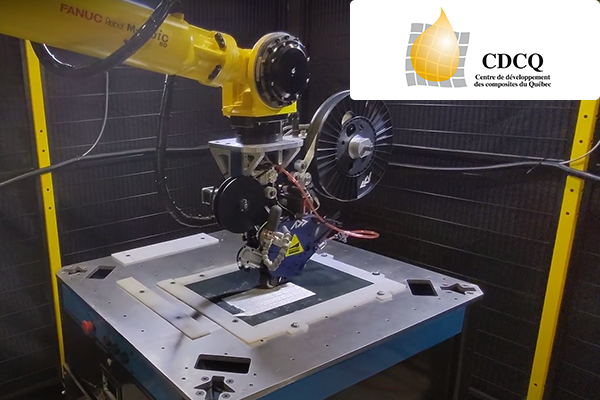Quebec composites development center installs AFP capability
Robotic cell by Effman, Fanuc and Addcomposites enables automation of complex composite layups with tailored fiber orientation for small and medium enterprises (SMEs).

Photo Credit: CDCQ
The Centre de développement des composites du Québec (CDCQ) at Cégep Saint-Jérôme (Québec, Canada) has installed an automated fiber placement (AFP) robotic cell developed by automation specialist Effman (Sherbrooke, Quebec, Canada) with the help of the FANUC robot and AFP head from Addcomposites (Espoo, Finland). The AFP technology enables layup of complex parts or preforms to be fabricated with aligned continuous fibers and very little manual labor. This new technology is intended to be accessible to small and medium enterprises (SMEs).
CDCQ offers manufacturing companies a wide range of services tailored to their needs in the composite materials sector. Based on the growing use of advanced composites in non-aerospace applications, CDCQ decided to invest in the technological know-how to support local companies.
CDCQ has issued a local call where partners can utilize the newly acquired capability to resolve their challenges, such as:
- Develop materials (tapes) with resins and reinforcements adapted to the non-aerospace needs including land transport, sports equipment and industrial applications;
- Hybrid reinforcements and increased areal weight (grams/square meter, GSM) tape reinforcements, as well as modified resins for fire and/or impact resistance;
- Make dry preforms for infusion molding or resin transfer molding (RTM) processes;
- In collaboration with other centers, work on the optimization of deposition head mechanics and robot trajectories as a function of the material characteristics and processing parameters.
Related Content
-
The next evolution in AFP
Automated fiber placement develops into more compact, flexible, modular and digitized systems with multi-material and process capabilities.
-
Rocket Lab begins installation of large AFP machine for rocket production
The 99-ton AFP machine, custom-designed and built by Electroimpact, is claimed to be the largest of its kind, expecting to save around 150,000 manufacturing hours in the Neutron rocket’s production process.
-
Plant tour: Joby Aviation, Marina, Calif., U.S.
As the advanced air mobility market begins to take shape, market leader Joby Aviation works to industrialize composites manufacturing for its first-generation, composites-intensive, all-electric air taxi.












